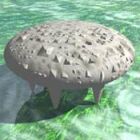BY LETTER
Bionanecology
 Image from Anders Sandberg |
Strictly speaking, natural carbon-based ecosystems area a form of bionanecology. The term however is more generally used to refer to artificial bionano, as opposed to naturally evolved bionano. Most bionanecologies and hylonanecologies tend to merge, with each using components found in the other; the difference between them being one of degree rather than of kind. In some cases however, unregulated bionanecologies can infect natural biosystems and biospheres with which they come in contact, leading to an explosion of hybrid lifeforms.
One of the most widespread forms of nanecology is the artificial gut flora that many bionts carry within their alimentary canal. This comes in many varieties, sometimes closely related to the original (baseline) flora, and sometimes capable of a wide variety of other functions. Rarely, a biont may chose to use an entirely non-biological hylonanecology in eir gut instead.
Related Articles
- Bioborg
- Biobots
- Biomedical Engineering - Text by M. Alan Kazlev
The design and development of medical technology, especially medical nanotechnology. Includes design and development of customized medical nanobots, synthetic biomaterials, large, small, cellular, and subcellular-scale body imaging and sensors, bio- and cybernetic implants and augmentations. - Biomimetics, Biomimesis
- Bionanite - Text by M. Alan Kazlev
An individual bionano unit - a biological/organic nanobot. - Bionano, Bionanotechnology
- Hylonanecology - Text by M. Alan Kazlev
A nanecology built solely on inorganic nanobots. The most extreme form is Machinonanecology. In practice however most hylonanecologies and bionanecologies tend to merge, with each using components found in the other; the difference between them being one of degree rather than of kind. - Hylonano - Text by Todd Drashner
Molecular Nanotechnology (dry nanotech). Use of artificially created non-biomolecular systems as replicators, assemblers, or components of molecular nanotechnology; any molecular nanotechnology not based on bio-molecules or biotech. Sometimes referred to as "Drexlerian nanotech". - Machinecology
- Nanite
- Nano-ecology, Nanecology - Text by Anders Sandberg
A distributed system of nanodevices and the structures constructed by them that self-organizes in a bottom-up manner without any central control; analogous to an ecology. Sometimes used to denote the entire nanosphere of a world, even when parts of it are under top-down control. - Nanobot
- Nanochondria - Text by Anders Sandberg in his Transhuman Terminology
Hylonano or bionano devices existing inside living cells, participating in their biochemistry (like mitochondria) and/or assembling various structures. A type of nanosome. - Nanodust - Text by Anders Sandberg
Layers of dead nanomachinery sedimenting in the dust, on the bottom of lakes and elsewhere. Ideally nanodust should self-destruct, but there are always bugs in that. Micro- and biotech scavengers collect them, but there are always places they miss. So the puddles on a roof collect diamond dust which blows away when they dry out, which can both erode shiny facades, irritate people and catch fire. - Nanoflu
- Nanomachine
- Nanomedicine
- Nanomedicine First Aid Kit (N-FAK)
- Nanosphere - Text by M. Alan Kazlev
Generally, the part of a — usually nanoindustrialised or nanodeveloped — world (or more rarely habitat) that is pervaded or saturated by nanodevices — the realm of nano-interaction. Typical angelnets for example constitute a nanosphere. - Nanoswarm
Appears in Topics
Development Notes
Text by M. Alan Kazlev
Initially published on 08 October 2001.
Initially published on 08 October 2001.






